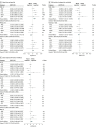Sleep Architecture, Obstructive Sleep Apnea, and Cognitive Function in Adults
- PMID: 37462968
- PMCID: PMC10354680
- DOI: 10.1001/jamanetworkopen.2023.25152
Sleep Architecture, Obstructive Sleep Apnea, and Cognitive Function in Adults
Abstract
Importance: Good sleep is essential for health, yet associations between sleep and dementia risk remain incompletely understood. The Sleep and Dementia Consortium was established to study associations between polysomnography (PSG)-derived sleep and the risk of dementia and related cognitive and brain magnetic resonance imaging endophenotypes.
Objective: To investigate association of sleep architecture and obstructive sleep apnea (OSA) with cognitive function in the Sleep and Dementia Consortium.
Design, setting, and participants: The Sleep and Dementia Consortium curated data from 5 population-based cohorts across the US with methodologically consistent, overnight, home-based type II PSG and neuropsychological assessments over 5 years of follow-up: the Atherosclerosis Risk in Communities study, Cardiovascular Health Study, Framingham Heart Study (FHS), Osteoporotic Fractures in Men Study, and Study of Osteoporotic Fractures. Sleep metrics were harmonized centrally and then distributed to participating cohorts for cohort-specific analysis using linear regression; study-level estimates were pooled in random effects meta-analyses. Results were adjusted for demographic variables, the time between PSG and neuropsychological assessment (0-5 years), body mass index, antidepressant use, and sedative use. There were 5946 participants included in the pooled analyses without stroke or dementia. Data were analyzed from March 2020 to June 2023.
Exposures: Measures of sleep architecture and OSA derived from in-home PSG.
Main outcomes and measures: The main outcomes were global cognitive composite z scores derived from principal component analysis, with cognitive domains investigated as secondary outcomes. Higher scores indicated better performance.
Results: Across cohorts, 5946 adults (1875 females [31.5%]; mean age range, 58-89 years) were included. The median (IQR) wake after sleep onset time ranged from 44 (27-73) to 101 (66-147) minutes, and the prevalence of moderate to severe OSA ranged from 16.9% to 28.9%. Across cohorts, higher sleep maintenance efficiency (pooled β per 1% increase, 0.08; 95% CI, 0.03 to 0.14; P < .01) and lower wake after sleep onset (pooled β per 1-min increase, -0.07; 95% CI, -0.13 to -0.01 per 1-min increase; P = .02) were associated with better global cognition. Mild to severe OSA (apnea-hypopnea index [AHI] ≥5) was associated with poorer global cognition (pooled β, -0.06; 95% CI, -0.11 to -0.01; P = .01) vs AHI less than 5; comparable results were found for moderate to severe OSA (pooled β, -0.06; 95% CI, -0.11 to -0.01; P = .02) vs AHI less than 5. Differences in sleep stages were not associated with cognition.
Conclusions and relevance: This study found that better sleep consolidation and the absence of OSA were associated with better global cognition over 5 years of follow-up. These findings suggest that the role of interventions to improve sleep for maintaining cognitive function requires investigation.
Conflict of interest statement
Figures

References
-
- Ribeiro S, Mello CV, Velho T, Gardner TJ, Jarvis ED, Pavlides C. Induction of hippocampal long-term potentiation during waking leads to increased extrahippocampal zif-268 expression during ensuing rapid-eye-movement sleep. J Neurosci. 2002;22(24):10914-10923. doi:10.1523/JNEUROSCI.22-24-10914.2002 - DOI - PMC - PubMed
MeSH terms
Grants and funding
LinkOut - more resources
Full Text Sources
Medical

